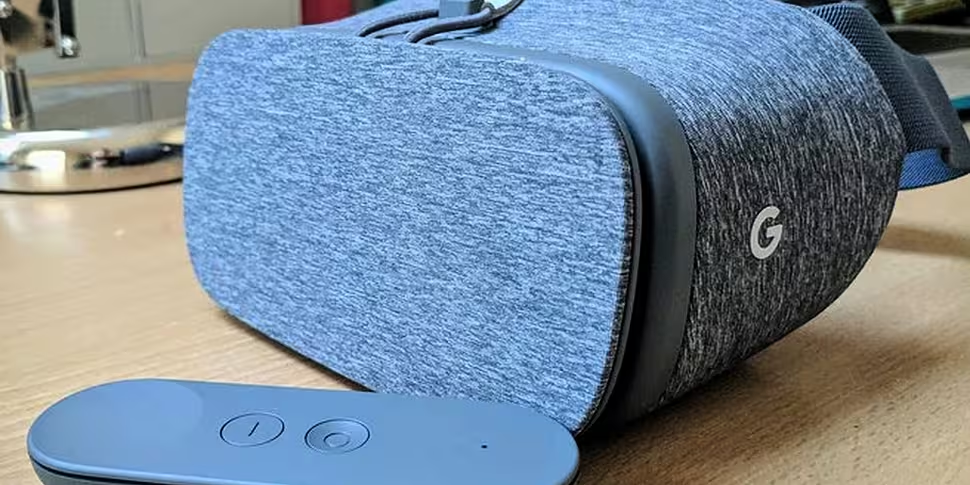Everywhere you turn these days someone is talking about virtual reality. It is THE next big thing in technology — or so we are led to believe — and now Google wants to make that future a reality.
It has launched the Daydream View, a VR headset which will cost €69, a fraction of the cost of the likes of the Oculus Rift, HTC Vive or PlayStation VR.
While those other products plug into your PC or games console and have their own screens, the Daydream View is leveraging your smartphone’s processing power and its display to make mobile VR a reality.
Samsung’s Gear VR is a comparable product, but Google’s big selling points here are its standalone Bluetooth controller and its VR version of the Play Store, which it hopes will be filled with unique VR games, videos and experiences from developers.
At launch, the store is pretty bare bones with just a couple of games and apps available. Google is promising lots more before the end of the year, but we will have to wait to see if developers embrace Google’s new future.
But what about the headset itself? Well, there are some positives and some negatives.
The Positives:
- At $79, it’s certainly affordable by most people who own a smartphone capable of displaying VR
- It looks nice - for a VR headset that it. You will still look ridiculous wearing it if you are in public, just slightly less ridiculous
- It’s really well built. I doubt Google is making much profit from selling this hardware, given the build quality
- Unlike Samsung’s Gear VR, it has a standalone controller that is easy to use and intuitive
- It works with smartphones other than just Google’s own Pixel phones. The openness of this device makes it much more attractive than Gear VR
The Negatives:
- For all Google’s talk about lightweight and breathable material, the View is still not very comfortable to wear, especially for long periods
- VR will kill your smartphone’s battery, fast
- It’s glitchy. The interface froze and the Bluetooth connection with the controller dropped a lot, which is really annoying
- Content is a problem. There are a handful of apps and games at launch and while more are promised, the app store is pretty bare-bones at the moment
- Games are expensive. $5.99 for shooter Hunter’s Gate and $3.99 for puzzle game Mekorama is pretty pricey
Google has a big advantage of the Gear VR here with its Bluetooth controller. When it worked, which admittedly was most of the time, it was great. It has a trackpad, three buttons and some motion control, meaning you can swipe, click and flick your way through games and the interface (which is really nice) quickly and intuitively.

There were two main problems for me with the Daydream View.
The first is comfort. I found that anything over 10 minutes of use and I was beginning to feel the strap pinch my head. Adjusting it is easy, but the problem returned quickly. The longest I used the device for in a single sitting was 30 minutes while playing Hunter's Gate, and I was constantly aware of the headset on my face.
If the goal of VR is to immerse you to the point of forgetting where you are, then Daydream fails on this point.
The other major sticking point I have is with the content.
OK, so Daydream just launched on Thursday and Google is promising much more content, but what I have difficulty in figuring out is just what type of content will make me come back to the View again and again.
Gaming is VR’s killer app but for me, this only works with dedicated devices like the PSVR or HTC Vive. On mobile the appeal of gaming was the easy and intuitive touch controls combined with the pick-up-and-play aspect of games like Angry Birds.
Gaming on VR is different. It is suited to the isolated experience of PC and console gaming. It is not an experience you do while on the train to work or sitting at your desk.
Beyond gaming, Daydream offers a couple of neat experiences with YouTube VR offering real awe-inspiring moments. The people I showed Daydream to, who hadn’t tried VR before, were blown away, but after the initial wonder faded, most got tired of it pretty quickly.

This is VR’s problem: stickiness. Of course we are never going to use VR as much as we are using our phones, but for Google to succeed in its plan to make VR mainstream and make money from it, it needs to keep people coming back again and again.
For that to happen, it will need to get developers on board to create the experiences that people want to have again and again. It’s unclear at this point if that is going to happen.









